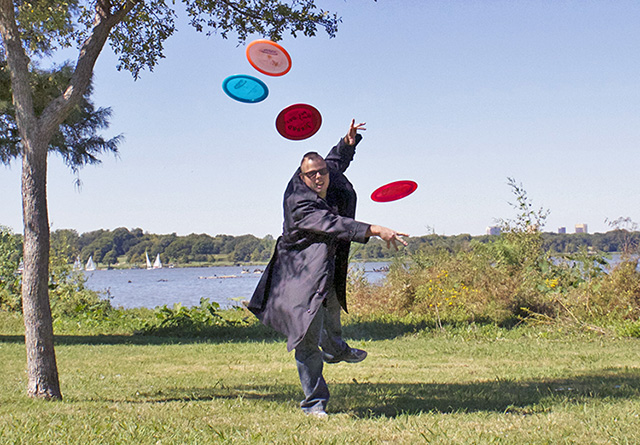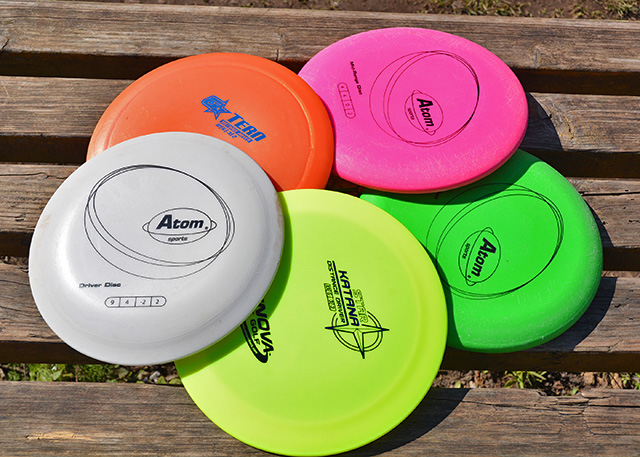Choosing the right disc for disc golf can feel like a daunting task, especially when you're new to the sport. With a myriad of options available, it's easy to get overwhelmed. But don't worry, we're here to help you navigate through the sea of choices.
 lots of discs
lots of discsUnderstanding the dynamics of disc golf discs is crucial. From disc types to plastic types, stability, and speed ratings, there's a lot to consider. We'll break it all down for you, making it easier to find your perfect match.
So whether you're a seasoned pro looking to fine-tune your game, or a beginner just getting started, stick with us. This guide from Prodigy Disc is designed to help you make the best choice for your needs.
Understanding Disc Golf Discs
Disc golf discs aren't just about colors and brands; they're a blend of various factors. These encompass disc types, plastic types, stability, and speed ratings. Acquiring an understanding of these elements isn't optional; it's critical for both beginner and seasoned players.
Disc Types
Primarily, there are three distinct disc types: putters, mid-range discs, and drivers. Putters, similar to putting clubs in ball golf, get utilized for short shots and when accuracy tops distance. Mid-range discs offer a balanced blend of accuracy and distance, best for intermediate shots. Drivers, on the other hand, are for long distances, boasting the least accuracy but optimal speed and distance.
Plastic Types
Disc golf discs come in a variety of plastic types. Each possesses unique properties, affecting disc performance and durability. For instance, DX plastic, known for being affordable and having a great grip, is less durable than Champion plastic. Champion plastic, while more costly, offers impressive durability and is more stable in flight than DX.
Stability
Stability refers to the disc's flight path. Disc golf discs span the spectrum from unstable (understable) to overstable. Understable discs turn right when thrown backhand (for right-handed players), ideal for beginners due to their ease of throwing. Overstable discs veer left, requiring more power and technique, usually preferred by advanced players.
Speed Ratings
Lastly, let's touch on speed ratings. They indicate the minimum speed required for the disc to fly as intended. Low-speed discs (1-3) are easy to control but lack distance. High-speed discs (10-13), conversely, cover more territory but are harder to control. As your skills develop, you'll gravitate towards discs with higher speed ratings.
Remember, it's not solely about finding a disc; it's about discovering the right disc for you. Understand your playing style and your skill level. Quit thinking, "What disc should I choose?" and start asking, "Which one suits me the best?" Knowledge about disc golf discs arms you with the tools to make an informed decision, ensuring your chosen disc complements your game plan.
Factors to Consider When Choosing a Disc Golf Disc
Disc golf disc selection relies heavily on numerous variables. Not only do we need to consider our skill level and playing style, but also environmental factors, the disc's physical characteristics, and our specific goals for the game.
Skill Level
Let’s start with our own skill level. Beginners often fare better with more understable discs (rating of -3 to -5), thus creating an easier control and straightforward flight path. Consider discs like the Leopard3, Tursas, or Diamond. As proficiency grows, graduate to discs with higher stability ratings.
Goal of the Play
The objective of the throw impacts disc choice. Seeking a long distance drive? Opt for drivers, such as the Destroyer or Teebird. For more accurate, short-distance throws, putters like the Aviar or Challenger prove ideal. Goals change with situations, as does disc selection.
Playing Environment
Environments dictate disc selection too. Tight, wooded courses call for more controlled, slower discs, think putters or midrange options. Contrastingly, open, windy conditions demand overstable discs, like the Firebird or Hades, for resistance against unpredictable wind patterns.
Physical Characteristics of the Disc
Disc golf disc attributes encompass factors such as weight, diameter, and plastic type. Lightweight discs (150-164 grams) offer less resistance while more substantial ones (165-180 grams) ensure stability, especially in windy conditions. Disc diameter affects grip and flight characteristics, with larger discs often more comfortable to hold and imparting greater glide.
Plastic Type
Lastly, plastic type influences disc performance and lifespan. Basic-level plastics, such as Innova DX or Discraft Pro-D, provide grip but compromise on durability. Premium plastics, including Innova Champion or Discraft Z-Line, ensure long-lasting durability though this comes at a more significant cost.
Informed disc selection therefore requires a comprehensive analysis of these factors, setting the stage for an improved performance and an enhanced disc golf experience.
 lots of discs
lots of discs Importance of Trying Different Discs
Differing in design, performance, and function, disc golf discs portray an immense variety. This diversity paves the way for players to experiment, learn, and grow. Trying out various discs enriches player's understanding of how each disc behaves in various conditions, facilitates skill development, and eventually, strengthens their game strategy.
A disc's behavior on the course depends on factors like its type, plastic, stability, and speed rating–each contributing to the flight path, distance, and accuracy, as discussed in the preceding sections. By practicing with different discs, players can examine the unique characteristics and behaviors of each disc. They start to grasp how a disc's speed rating correlates with its flight or how an overstable disc reacts differently than an understable one. For instance, high-speed discs, like the Innova Destroyer, require substantial arm speed and power, whereas lower-rated discs, like the Discraft Buzzz mid-range, prove forgiving for beginners.
Weather conditions also dictate disc performance. A disc golf player might choose a heavier, more stable disc for a windy day, like the Dynamic Discs Lucid-X Felon driver, but might go for a lighter, understable disc, like the MVP Orbital driver, when the course is calm. Continuous experimentation with these variables enables players to formulate effective strategies for varying play conditions.
Additionally, mastering a diversified disc selection allows players to adjust based on the course layout. Depending on the distance to the basket or the obstacles in the way, a player may select a mid-range disc for accuracy over a driver for distance–a strategic call made possible only through the hands-on experience of trying different discs.
In a nutshell, experimenting with a variety of discs provides significant insight into diverse flight characteristics. It sparks the development of flexible strategies and boosts confidence on the course. Henceforth, attempting various discs turns out to be an essential step in progressive disc golf gameplay.
Advantages of Having a Variety of Discs
Owning a rich disc collection gives players an edge in disc golf. Varied discs allow for tailored game strategies, enhancing gameplay and scoring opportunities.
- Enhanced Versatility: Numerous discs allow for varied play styles. Players may choose a high-speed driver for maximum distance, a mid-range disc for control and accuracy, or a putter for close shots and precise landings. For instance, one might use a driver for an open field and a mid-range disc for a densely wooded area.
- Adaptability to The Environment: Weather conditions play a crucial part in disc golf. A disc that works well on a calm day might not exhibit optimal performance under windy conditions. Thus, a mix of stable and understable discs helps players adjust to various environmental factors.
- Improved Learning Curve: Experimenting with different discs can accelerate a player's learning trajectory. It allows them to understand how disc properties like speed, stability, and plastic material impact disc flight. For example, players can learn why a disc with high-speed rating requires more power, or how understable discs tend to turn right (for a right-handed backhand throw).
- Reduced Wear and Tear: Rotating between discs can minimize wear and tear, extending their lifespan. Players often have favorite discs. Using these exclusively may degrade them quickly. In contrast, rotation ensures balanced use of all discs, maintaining their quality and performance levels.
Having a variety of discs does not mean carrying every kind available. It's about having a well-curated collection that meets personal playing style, level of expertise, and the various challenges presented by different courses. Keep in mind, it's not quantity, but quality and diversity that counts. By including a thoughtful mix of putters, mid-range discs, and drivers, players can tackle any situation, weather, and course, ensuring that their love for disc golf only grows stronger.
Buying Tips for Disc Golf Discs
Focusing on quality, diversity, and suitability, we present our top buying tips that'll aid in choosing the right disc golf discs. Having put many disc models through our paces, we've conjured five expert tips.
- Understand the disc golf specifications, including disc types, plastic variations, stability, and speed ratings. Knowing the specifics offers insights into their performance capabilities and can direct you towards discs suitable for your skill level and playing style. For example, beginners might go for low-speed discs that provide controlled flight paths, while more experienced players could opt for high-speed discs that offer greater distance.
- Choose a blend of disc types. Ideally, your collection should include putters, mid-range discs, and drivers. Here's one instance: putters, for close range throws and improving accuracy; mid-range discs, for reliable, consistent throws; and drivers, for maximum distance. Variety in your disc arsenal not only helps tackle different situations but also provides opportunities to experiment and enhance your game.
- Select the right plastic type. With different plastics offering unique features, the right choice depends mainly on your personal preference and playing environment. For instance, premium plastics give durability and improved performance, making them ideal for rugged terrains.
- Prioritize flight characteristics over disc color, no matter how much you're tempted by an aesthetically pleasing design. Essential flight traits like speed, glide, turn, and fade significantly affect a disc's performance in the field.
- Buy from reputable sources, as they provide quality assured products and often facilitate provisions like returns and exchanges, if necessary. Look specifically for credible online and offline stores, and check the reviews and ratings before making the purchase.
Relying on these buying tips, abetting your disc golf knowledge from the previous sections, you're all set for a dynamic disc selection process. Remember, though, it's not about owning the most discs, but about owning the right discs that align with your playing style, skill level, and course challenges.
So, we've explored the ins and outs of choosing a disc golf disc. We've learned the importance of knowing the different disc types, plastic variations, stability, and speed ratings. We've seen how putters, mid-range discs, and drivers each play their unique roles. We've discovered that the right plastic type can make a difference in durability and performance, and that stability and speed ratings can guide us to the perfect disc. We've also shared some valuable tips to help you make the right purchase. Remember, it's all about finding the right blend of discs that suit your style, level, and course. And always buy from trusted sources. Here's to elevating your disc golf game and finding joy in every throw!
Related Pages
- Disc Golf Equipment
- About disc golf, and other Disc Sports
- Rules for Disc Golf
- Disc Golf videos are viewable on disc sport videos
- Equipment for Ultimate
- A summary of disc golf
- Equipment for Sports
- Information about All Sports and also a list of Unusual Sports


 Current Events
Current Events